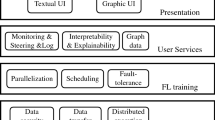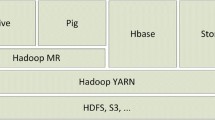Abstract
The assumption that the number of training samples is less than the number of pixels in a face image is essential for conventional eigenface-based face recognition. But recently, it has become impractical for massive face image collections. A parallel processing method using distributed eigenfaces is presented. A massive face image set was divided into a bunch of small subsets that satisfied the assumption of conventional approaches. Eigenfaces were extracted from the subsets and stored in a cloud system. Face recognition was performed by parallel processing using the distributed eigenfaces in the cloud system. A face recognition system was implemented in the Hadoop system. Various experiments were performed to test the validity of the distributed eigenface-based approach. The experimental results show that, compared to conventional methods, the implemented distributed face recognition system worked well for large datasets without significant performance degradation.














Similar content being viewed by others
References
Agarwal M, Agrawal H, Jain N, Kumar M (2010) Face recognition using principle component analysis, eigenface and neural network. In: 2010 International conference on signal acquisition and processing, pp 310–314
Becka M, Vahtersic M (1999) Block-Jacobi svd algorithms for distributed memory systems ii: meshes. Parallel Algorithms and Applications 14(1):37–56
Bello-Orgaz G, Jung JJ, Camacho D (2016) Social big data: recent achievements and new challenges. Information Fusion 28:45–59
Brunelli R, Poggio T (1993) Face recognition: features versus templates. IEEE Trans Pattern Anal Mach Intell 15(10):1042–1052
Chellappa R, Wilson CL, Sirohey S (1995) Human and machine recognition of faces: a survey. Proc IEEE 83(5):705–741
Chen LF, Liao HYM, Ko MT, Lin JC, Yu GJ (2000) A new lda-based face recognition system which can solve the small sample size problem. Pattern Recogn 33(10):1713–1726
Dean J, Ghemawat S (2008) Mapreduce: simplified data processing on large clusters. Commun ACM 51(1):107–113
Foster B, Mahadevan S, Wang R (2012) A GPU-based approximate SVD algorithm. Springer, Berlin, pp 569–578
Gandomi A, Haider M (2015) Beyond the hype: big data concepts, methods, and analytics. Int J Inf Manag 35(2):137–144
Guo G, Li SZ, Chan K (2000) Face recognition by support vector machines. In: Proceedings fourth IEEE international conference on automatic face and gesture recognition (cat. no. PR00580), pp 196–201
Halko N, Martinsson PG, Shkolnisky Y, Tygert M (2011) An algorithm for the principal component analysis of large data sets. SIAM J Sci Comput 33(5):2580–2594
Hall PM, Marshall D, Martin RR (1998) Incremental eigenanalysis for classification. In: British machine vision conference, pp 286–295
Kawale MR, Bhadke Y, Inamdar V (2014) Parallel implementation of eigenface on cuda. In: 2014 International conference on advances in engineering technology research (ICAETR - 2014), pp 1–5
Seshadri G, Jain R, Mittal A (2010) Parallelization of principal component analysis (using eigen value decomposition) on scalable multi-core architecture. In: 2010 IEEE 2Nd international advance computing conference (IACC), pp 44–49
Torralba A, Fergus R, Freeman WT (2008) 80 million tiny images: a large data set for nonparametric object and scene recognition. IEEE Trans Pattern Anal Mach Intell 30(11):1958–1970
Toygar O, Acan A (2004) Multiple classifier implementation of a divide-and-conquer approach using appearance-based statistical methods for face recognition. Pattern Recogn Lett 25(12):1421–1430
Turk M, Pentlan A (1991) Eigenfaces for recognition. In: Journal of cognitive neuroscience, vol 3. MIT Press, pp 71–86
Zhao H, Yuen PC, Kwok JT (2006) A novel incremental principal component analysis and its application for face recognition. IEEE Trans Syst Man Cybern B Cybern 36(4):873–886
Acknowledgements
This research was supported by the Chung-Ang University Excellent Student Scholarship and by Basic Science Research Programs through the National Research Foundation of Korea(NRF) funded by the Ministry of Education(NRF-2016R1D1A1B03936349 and NRF-2016R1D1A1B03933895).
Author information
Authors and Affiliations
Corresponding author
Rights and permissions
About this article
Cite this article
Park, JK., Park, HH. & Park, J. Distributed eigenfaces for massive face image data. Multimed Tools Appl 76, 25983–26000 (2017). https://doi.org/10.1007/s11042-017-4823-6
Received:
Revised:
Accepted:
Published:
Issue Date:
DOI: https://doi.org/10.1007/s11042-017-4823-6




